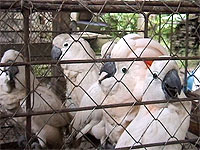|

|
Home
> News & Events > MAARSianChronicles
> Issue 13: August 2005 > Did You Know?:
Extinction is Not Just for Dinosaurs
Did You Know?
| 
Seram (Moluccan) Cockatoos shortly after
their confiscation from smugglers by Forestry Officers on
Seram Island, Indonesia.
(Photo by Tex Hankey)
|
|
Extinction is Not Just for Dinosaurs
by Dr. Stewart Metz, Indonesian
Parrot Project, and Eileen McCarthy, MAARS Executive Director
Indonesian cockatoos — and other native animals
— continue to be at risk of future extinction despite local law
and international treaties. Conservation efforts can only be successful
on the rare occasion when resources, legal protection and enforcement,
cooperation between governmental agencies, field biologists, researchers,
and the local human population converge to address the complex, multi-dimensional
issues that threaten the species in question.
In Indonesia — as in many countries where threatened
species are endemic — poverty, civil unrest, a lack of resources,
under-developed national infrastructure, and the practical challenge
of enforcing wildlife and habitat protections on as many as 18,000 islands,
present formidable obstacles to the success of conservation efforts.
| 
|
The Moluccan Cockatoo (Cacatua moluccensis,
also called Seram or Salmon-crested Cockatoo) is now found naturally
in the wild only on the Island of Seram, Indonesia; it is extinct
on the Islands Saparua and Haruka which were once part of the
species' natural range.
|
| 
|
The total wild population of Moluccan Cockatoos
on the Island of Seram is estimated at only 70,000 to 100,000
birds.
|
| 
|
Nearly 70,000 Moluccan Cockatoos were legally
exported between 1983 and 1990 before the Moluccan Cockatoo was
listed on CITES Appendix I as critically endangered (threatened
with extinction) and, therefore, protected from unrestricted international
trade.
|
| 
|
The Citron Cockatoo (Cacatua sulphurea citronocristata),
a sub-species of the Lesser Sulphur-crested Cockatoo (Cacatua
sulphurea, also called the Yellow-crested Cockatoo) naturally
inhabits only the Island of Sumba, Indonesia.
|
| 
|
About 80–90% of forest adequate for the
survival of the Citron Cockatoo on the Island of Sumba has been
destroyed.
|
| 
|
A study conducted in 1993 estimated the wild
population of Citron Cockatoos to be as low as 2,500 individuals.
|
| 
|
The Goffin's Cockatoo (Cacatua goffini)
was listed on CITES Appendix I, which prohibits the export of
the species, in 1992. From 1983 to 1989, 52,000 Goffin's Cockatoos
were recorded in international trade.
|
| 
|
The legal quota for the capture of wild Umbrella
Cockatoos (Cacatua alba) is zero.
|
| 
|
In 2004, the Lesser Sulphur-crested Cockatoo
(including the Citron Cockatoo) was placed on CITES Appendix I
which greatly restricts the capture and international commercial
trade of listed species.
|
| 
|
At least one estimate states that 60–70%
of logging activities in Indonesia constitute illegal logging.
|
| 
|
Logging, wet rice cultivation, and illegal trapping
continue to pose real threats to the wild populations of Moluccan
Cockatoos on Seram and Citron Cockatoos on Sumba.
|
| 
|
At least 15,000 parrots are trapped annually
from the Northern half of the Moluccan Islands alone. This estimate
includes more than 1,600 Umbrella Cockatoos, 4,800 Chattering
Lories (Lorius garrulous), 7,700 Violet-necked Lories
(Eos squamata) from just two suppliers. Many of these
birds are trapped in violation of Indonesian law and/or CITES.
|
| 
|
At the major Indonesian bird markets, an estimated
1,600 Black-capped Lories (Lorius lory), 980 Red Lories
(Eos bornea), 180 Goffin's Cockatoos (Cacatua goffini),
320 Triton and Eleanora Cockatoos (Cacatua galerita triton
and Cacatua galerita eleonora) and 700 Lesser Sulphur-crested
Cockatoos might be traded annually.
|
| 
|
On Seram Island, one principal broker might
have 20–50 Moluccan Cockatoos, 200 Red Lories, and 350 Rainbow
Lorikeets (Trichoglossus haematodus) in her possession
at any one time, although legal trapping quotas for Moluccan Cockatoos
and Red Lories are zero.
|
| 
|
A single trapper can capture up to 16 cockatoos
per month within the bounds of Manusela National Park where the
birds are supposed to be protected.
|
| 
|
The price paid to trappers by brokers for illegally
captured Moluccan Cockatoos has risen from about $5 to about $25
over the past several years, as it has become harder to find and
trap the birds. If the bird survives export, a Moluccan Cockatoo
might retail in Europe or Asia for 30 to 100 times the price the
local broker paid.
|
Sources
"Flying
Without Wings," KSBK (now ProFauna Indonesia), May 2002, http://www.profauna.or.id/English/flying-without-wing.html
"Flying
Without Wings (Part II): Investigation by ProFauna Indonesia of Parrot
Trapping on Seram Island, Maluku, Indonesia," July 2004, http://www.profauna.or.id/English/flying-without-wing2.html
CITES:
How CITES Works (Appendices), www.cites.org/eng/disc/how.shtml
"Determining
the Status of the Seram (Salmon-crested) and the Sumba (Citron-crested)
Cockatoo: Practice and Pitfalls," Dr. Stewart Metz, Project
Bird Watch/Indonesian Parrot Project, http://www.indonesian-parrot-project.org/status.html
|
|